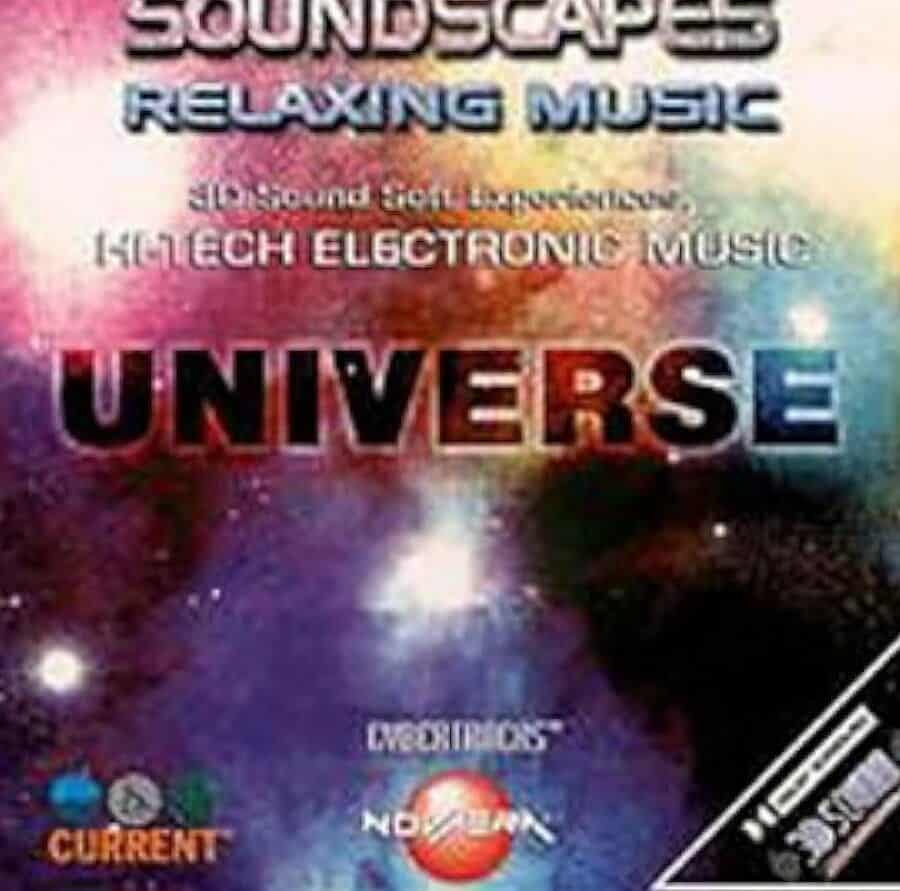Discover the captivating sounds of space, as the Earth, Sun, and planets emit their own distinct melodies throughout the vast expanse of the universe. Delve into the cosmic symphony in high-quality audio, available for free online. Experience the celestial music of the cosmos.
An Assortment of Cosmic Soundscapes
Space Sounds: “Melodies of the Stars” Unveiling Love Stories
The melodies of space conceal extraordinary narratives tied to various cosmic entities. This extraordinary harmony emerges from the interplay of solar winds and celestial phenomena. Through 11 compositions, the essence of the universe is unveiled, resonating deep within the human heart and subconscious mind.
Thanks to the diligent efforts of Voyagers and J. Thompson, we can now revel in these celestial formations, allowing ourselves to be fully immersed in the boundless wonders of space.
The melodies of the Universe will bring to mind something familiar and native. Among the associations are the rustling of the wind, the striking of lightning, and the whispers of formations in space.
Sounds of space: Io
Io serves as a moon of Jupiter. When you listen to her song from outer space online, it feels like slowly and quietly sinking into a peaceful light cloud. You are surrounded by the wind, an incredible orchestra of unfamiliar instruments, and the singing of dolphins. It gives you the impression that you are in a state of bliss. And you can hardly imagine that this object is actually a living flame.
This is one of the most active volcanic places in our system. The vents emit sulphurous smokestacks that reach a height of 300 kilometers, and the surface is covered with lava rivers.
The discovery was made in 1610 by Galileo Galilei. He mistakenly identified this satellite as Europa.
Ancient Greece’s inhabitants identified the colossal celestial body Saturn as Kronos, one of the Titans. It’s no wonder that they held a deep fear for this entity, as the legend goes that Kronos devoured their offspring. The immensity of Saturn’s dimensions would indeed enable it to effortlessly consume 769 Earths.
Space-borne melodies emanate from Saturn as the rings, ionosphere, and moons interact with the elements present in the stellar wind. These cosmic sounds encapsulate the power and might of the wind and hurricane-like forces in play.
While Saturn falls second only to Jupiter in terms of size within the solar system, it will forever be renowned for its awe-inspiring ring system.
The Unique Sound of Saturn’s Rings
Saturn’s ring system produces an incredibly captivating sound. These melodic vibrations immerse us in a three-dimensional experience, awakening every cell in our body. It’s as if our entire being responds to this cosmic rhythm.
The existence of Saturn’s rings was first discovered by Galileo Galilei in 1610. Through the power of his telescope, he observed what appeared to be knobs, which he initially mistook for satellites. Later, in 1655, Christian Huygens discussed the rings in more detail using an improved model.
In reality, there are actually many more rings than initially thought. Composed of a combination of ice and rock particles, the rings vary in size. The thickest ring measures up to 900 meters, while the outermost ring extends beyond the planet’s diameter by a staggering 200 times.
Sounds from Outer Space: Uranus
Uranus has the ability to induce a meditative state. The celestial melodies produced by the interaction between the solar wind and the planet’s ionosphere create a unique blend of power and tranquility, resembling cosmic vortices.
Ranked as the 7th planet in our solar system, Uranus also boasts a set of rings. Interestingly, these rings were not discovered until 1977, by mere chance. Astronomers at the Kuiper Observatory were observing the impact of Saturn on nearby stars when they noticed an unusual overlapping of the stars’ positions, indicating the presence of another celestial body.
Sounds of Space: Uranus’s Ring Symphony
These rings possess an unparalleled singularity and captivation. When you indulge in the symphony, it transports you to the pinnacle of a towering mountain, where a solitary monk serenades. It serves as an exquisite selection for meditative rituals and introspective exercises.
Mysterious fragments of obsidian composition coalesce to form intricate ring systems, reflecting minimal sunlight. The precise constituents remain elusive, although it is generally surmised that frigid elements are absent from this celestial ensemble.
Sounds from Outer Space: Miranda
Miranda has a one-of-a-kind symphony in the cosmos, capable of morphing from the menacing howls of a hurricane to the enchanting songs of alluring sirens.
Measuring a mere 500 kilometers in diameter, this moon has managed to capture nearly every feature found in our solar system. The surface temperature of this icy world can drop as low as -187°C. Upon closer inspection, it resembles a disheveled jigsaw puzzle with jutting corners, craters, depressions, and valleys.
Sounds of Space: Neptune
The soundscapes of Neptune are ever-changing and unique. They have the power to both soothe and stir the depths of one’s soul. This distant planet, devoid of the sun’s warmth, communicates with us through the language of icy fragments.
Neptune, aptly named after the god of the seas, is composed of methane that absorbs infrared radiation, along with hydrogen and helium. In the frigid temperatures of -214°C, these elements condense into a vast layer of ice, which surpasses Earth in mass by 17 times and in volume by 58 times.
Is it possible to hear the Earth’s sounds from outer space? Absolutely! Our planet produces beautiful melodies as a result of the interaction between the ionosphere and the solar wind. We can hear the joyful cries of dolphins, the powerful crashing of waves, and the gentle whispering of leaves. It is the harmonious voice of life.
This soothing and earthy symphony surrounds us like a warm and comforting cocoon, promising peaceful dreams. Interestingly, this recording has been used by Japanese television crews to help children who have trouble sleeping.
The Voyager spacecraft has captured 12 melodies from space. These cosmic sounds have served as the inspiration for various musical compositions. Here, you can listen to the captivating music of the universe for free online.
The exploration of the phenomenon known as “space music” can be traced back to 1989. Jeffrey Thompson conducted research using various sound vibrations to address psychological issues. He became curious about the actual sounds from space that had been captured by the Voyager 1 and 2 spacecraft. As he delved deeper into his investigations, he discovered that many planets emit unique sounds that travel through the vacuum of space. With the collaboration of NASA and research institutes, Thompson embarked on a comprehensive study.
It was revealed that the collision between the solar wind and the ionospheres of celestial objects generates ionized sound waves. These waves are then transmitted through vibrations and captured by the sensors of the spacecraft. Spanning a frequency range of 20-20000 Hz, these melodies can be perceived by the human ear.
It was truly astonishing that the distinct sounds emanating from the celestial bodies were strikingly akin to the ones generated by our anatomies and the natural world. Now you are aware of the existence of sounds in the vast expanse of space and how they permeate the entirety of the cosmos. The melodic symphony of the cosmos is utterly captivating and serves as a poignant reminder of our shared origins. You have the opportunity to freely indulge in the auditory compositions derived from the depths of space via the internet. Let us revel in the experience of listening to space’s harmonious melodies online, free of charge.
A compilation of space sounds
Space Sounds: Sounds of Rocket Engines

Space Sounds: SLS Test Launch
SLS stands for the Space Launch System, an American super-heavy launch vehicle used for crew-controlled missions. It is responsible for delivering cargo into orbit and serves as a replacement for the Ares 5 booster. Take a listen to recordings capturing the sounds of rockets venturing into space.
This article is focused on the J-2 rocket engine, which is powered by liquid fuel. It was developed by Rocketdyne and uses an open generator cycle design. When it was first introduced, it was hailed as the most powerful engine of its kind, running on a combination of liquid hydrogen and oxygen.
Listen to the Sounds of Space: Atlas V launch
The Atlas V is a two-stage launch vehicle that is used only once, and it is part of a larger group of rockets with the same name. Originally created by Lockheed Martin, it is now operated by United Launch Alliance.
A compilation of space sounds: solar system and beyond
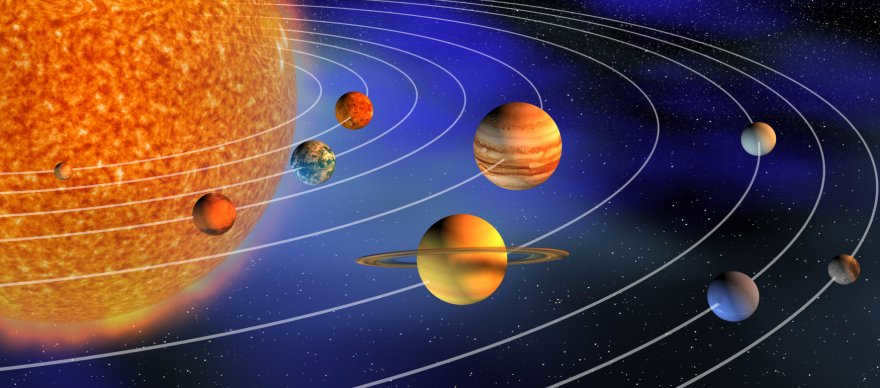
If you were to compare the phenomenon of sound in space to something, it would be most similar to thermal noise. This type of noise is produced at frequencies above 15 MHz when antennas are pointed towards the sun or other powerful sources such as the galactic center. Distant quasars and other dense objects emit electromagnetic waves that can also be picked up by radios. Additionally, there are instances where radios can detect the impact of meteorites. Another form of space noise is relic radiation, which is the faint echo of the Big Bang that permeates the entirety of space in a uniform manner. The peak frequency of relic radiation is in the microwave range.
Sounds from the Cosmos – The distinctive sound of radio waves as they interact with the Earth’s atmosphere
Radio waves possess the remarkable ability to traverse vast distances through the Earth’s atmosphere with minimal loss. This unique characteristic has made them an ideal means of transmitting information.
Aural Wonders of Space: Quindar – Sound #1
The presence of Quindar tones can easily indicate the recording of astronauts’ conversations and the reception point on Earth. These high-frequency squeaks manifest in the gaps between spoken words.
If you’ve ever listened to vintage recordings from the Apollo missions, you may have come across the distinctive “quindar tones”. These tones were used as a special method of communication between the ground crew and the astronauts aboard the spacecraft. This technique was adapted from the principles of two-way radios.
Sounds of Space: Sputnik – Beep-Beep
In 1954, Soviet radio broadcasted a message from Yuri Levitan, announcing the successful creation of the world’s first artificial Earth satellite. The satellite, known as Sputnik, was launched on October 4th, and its call signs were transmitted as “Beep! Beep!”
Sounds from the Cosmos: Cassini – Saturn’s radio waves
Throughout the duration of the Cassini mission, the spacecraft successfully captured and documented radio signals emanating from locations at Saturn’s northern and southern poles.
Sounds from the Cosmos: Voyager – Thunderstorms on Jupiter
It is surprising to discover that there are active lightning bolts on this enormous entity. This phenomenon demonstrates the rapid movement of particles with an electrical charge from one location to another. In order for a noticeable “sparkle” to occur, it is necessary for the charges within the cloud to be separated. On our planet, this separation is caused by the collision of liquid and frozen water droplets. In the case of Jupiter, cloud ice also plays a role in this process. This conclusion was drawn based on the image captured by the Galileo spacecraft. Bright flashes can be observed in areas where water clouds are present. These flashes illuminate the ammonia cloud formations beneath them. It is important to note that these lightning bolts on Jupiter are more intense than those on Earth.
Sounds from the Cosmos: Voyager – Recording the Melody of Interstellar Plasma
Voyager 1 became renowned for its extraordinary feat of surpassing the confines of our solar system and capturing the enchanting sounds of interstellar plasma. The team’s spokesperson, Don Garnett, joyfully announced this groundbreaking discovery.
Sounds from the Cosmos: Stardust – A Close Encounter with Comet Tempel 1
In 1999, the Stardust spacecraft embarked on its mission to explore the depths of space. It successfully retrieved samples from the surface of Wild (81P/Wild 2) in 2004. The capsule containing these invaluable specimens was received by scientists two years later. The spacecraft, now known as Stardust-NExT, continued on its remarkable journey and rendezvoused with its newest target, Comet Tempel-1, in 2007. However, due to dwindling fuel reserves, this mission marked its final expedition.
We have the opportunity to not only enjoy the melodies of planets, but also the melodies of stars. This recording was captured by the Kepler telescope.
Sounds of Space: Kepler – converting the light from star KIC7671081B into sound
An extraordinary space telescope has successfully detected a vast array of celestial objects. However, we have achieved even more than that. It turns out that we can transform the flickering of stars into melodic tunes and listen to the singing of a star. As a result, we now have the melodic voices of KIC7671081B and KIC12268220C.
Sounds of Space: Juno – “PRIVATE” code transmitted from Earth
The Juno spacecraft was launched towards Jupiter in 2011 as part of NASA’s New Frontiers project. By 2016, the mission successfully established its orbit and reached the polar region of the planet. The primary objectives of the mission included studying the gravitational and magnetic fields of Jupiter, as well as investigating the presence of a solid core.
Sounds from the depths of space: Cassini captures the unique sound of Enceladus
As Cassini approaches the final stages of its mission, it continues to explore the mysteries of Saturn’s rings. In addition to its scientific discoveries, the spacecraft has also captured the ethereal sounds emitted by the planet itself, thanks to its RPWS instrument. These mesmerizing sounds are created by the interaction of particles in the D ring, resulting in captivating plasma waves.
Sounds from the Depths of Space: Plasmaspheric Whistling
In the upper reaches of the atmosphere, cosmic rays hold dominion. Their potent energy poses a significant threat, not only to satellites but also to the well-being of individuals venturing into the vastness of outer space. This phenomenon is known as plasmaspheric whistling. Electromagnetic waves generate a unique sound akin to the ethereal white noise.
Sounds emanating from the depths of space: Plasma Waves
These are electromagnetic waves that traverse through the plasma medium as a result of the orderly movement of charged particles. The electromagnetic properties of plasma are primarily dependent on the interaction between particles, as well as the presence of external fields and wave characteristics.
Believe it or not, the cosmos is not devoid of sound. In fact, it teems with a symphony of sounds created by various forms of electromagnetic waves such as infrared, gamma rays, and X-rays. They all converge to produce a peculiar yet captivating melody that I invite you to explore.
Do you think space is completely silent? Think again. But can an ant perceive our celestial music? Can a group of worms, voyaging on a fragment of space rock covered in a thin layer of organic matter, believe themselves to be the rulers of the galaxy? For some inexplicable reason, those worms seem to think so.
It’s akin to the Earth being bombarded.
Imagine placing the sun inside a massive chamber – have you ever wondered what it would sound like?

Stunning sights of our celestial satellite.
This footage utilizes information gathered by the Lunar Reconnaissance Orbiter probe.

The Sounds of the Universe
This iconic picture captures the Pillars of Creation, a region where stars are formed in the Eagle Nebula. Not only can we visually observe it, but we can also perceive it through sound! Scientists are connecting sound with data to provide us with a fresh perspective on the image.
Technically, there are no actual sounds in space as it is a vacuum where sound waves cannot travel. However, in this case, a range of sounds has been artificially synthesized, with the synthesized sound changing based on the line scanning the image and passing through different areas of color and brightness. In other words, the tonality and spectrum of the created sound correspond to different slices of the image. Many thanks to @Mefodi for the clarification.

Unique Mars Panorama with Audio
A brand new, high-quality panoramic view of Mars accompanied by authentic sound recordings from the red planet has recently been released.
NASA has just unveiled a stunning 360-degree panorama of the Van Zyl Overlook on Mars, captured by the Perseverance rover. The breathtaking panorama is now available on the official YouTube channel of NASA’s Jet Propulsion Laboratory.
This extraordinary visualization was created using the cutting-edge Mastcam-Z system and is composed of a total of 992 individual images meticulously stitched together, resulting in an astonishing 2.4 billion pixels.
The images were captured over a period of 11 days, from April 15 to April 26, 2021. Additionally, an image of the rover taken on March 20, 2021, during the 31st day of the mission, was included in the panorama to provide a sense of scale and offer a unique perspective from the rover’s vantage point.
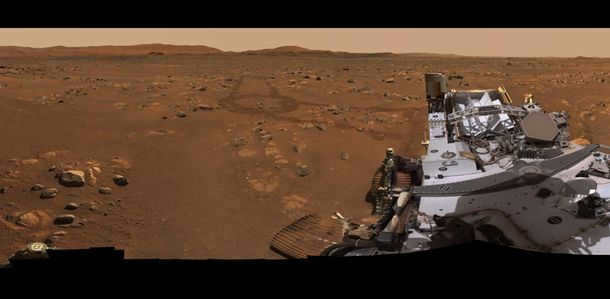
Can we expect that our messages sent into space will be comprehended?
These four probes are equipped with plaques or recordings that have been specifically created to elucidate their origins to anyone who might come across them.
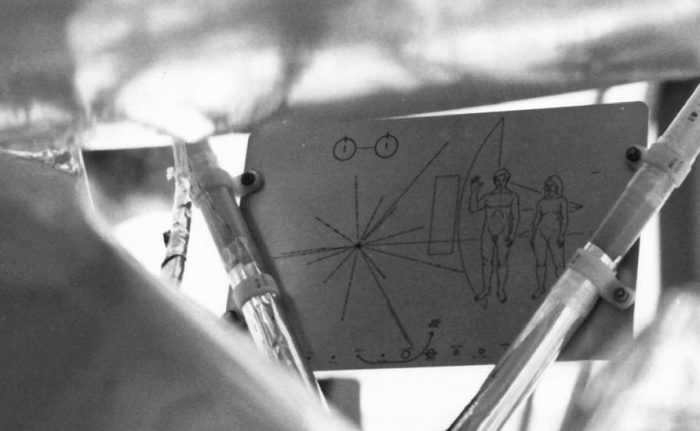
A plaque affixed to the interstellar probe Pioneer 10
The interstellar probes Pioneer and Voyager are renowned for carrying messages intended for any potential discoverers in the future. Both Pioneer probes bear a plaque while the Voyager probes bear a phonograph record. The creation of these artifacts required an immense amount of effort, but the question remains: can an extraterrestrial observer truly comprehend the messages we have transmitted into the depths of space?
While it’s impossible to assume how these messages will be interpreted, let’s imagine that extraterrestrial beings capable of discovering a spaceship have senses similar to ours, allowing them to see or hear. Each message was carefully crafted to not only convey specific information but also to facilitate understanding through universal concepts.
Pioneer 10 and 11 feature a 15 x 23 cm golden aluminum plate attached to the spacecraft bus, created by Carl Sagan and Frank Drake. The artist responsible for engraving the images on the plaque was Linda Salzman Sagan, Sagan’s wife at the time.
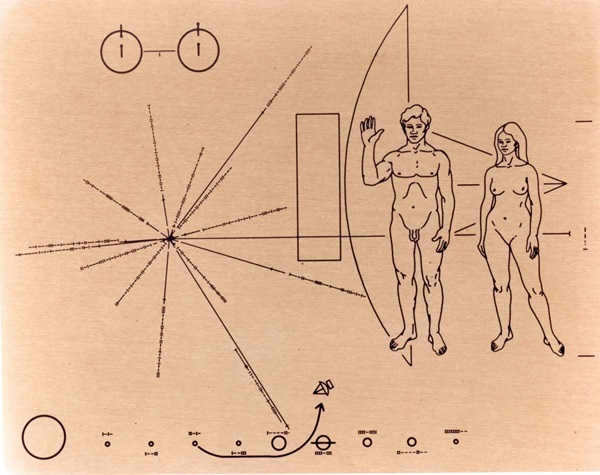
The gold anodized aluminum plate called the Pioneer plaque features engravings of various images.
One of the most notable characteristics of the plaque is the depiction of a male and female figure atop the outline of the Pioneer spacecraft. This effectively represents our physical form and highlights the presence of sexual dimorphism in humans. However, the facial features of the couple lack intricate details, such as the absence of visible ears. Both individuals have closed mouths, which may not be immediately recognizable as such. Originally, the initial sketch included a portrayal of the man and woman holding hands. Yet, Sagan promptly recognized that extraterrestrial beings might interpret this as a representation of a singular living entity. Consequently, the drawing was adjusted accordingly.
Regarding the scientific information provided, the top left section of the diagram displays the two fundamental states of the hydrogen atom. The emission wavelength of neutral hydrogen, which is measured at 21 centimeters, is used as the standard unit of measurement for dimensions and distances in this communication. If one can deduce that this is a depiction of hydrogen, the concepts of time and distance should be readily understandable.
In addition, the plaque features a depiction of our Sun in relation to 14 pulsars, as well as the center of our galaxy. The distances to the pulsars and their frequencies are represented using binary notation. Due to the abundance of objective data conveyed in this image, extraterrestrial beings may find it relatively easy to interpret.
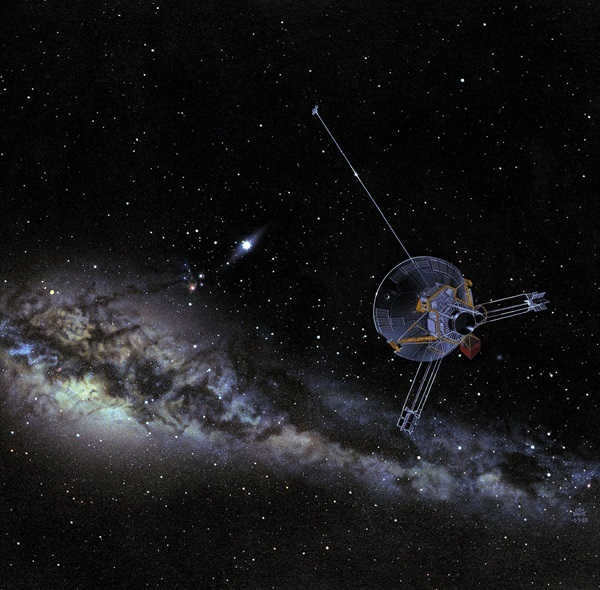
An adventurer exploring the depths of outer space
Ultimately, the plaque includes a visual representation of the solar system. The solar system diagram is likely one of the most straightforward components of the plaque, showcasing the Pioneer’s origin from a third planet. At the time of its creation, the plaque acknowledged Pluto as the ninth planet (prior to the discovery of other trans-Neptunian dwarf planets like Erida and Sedna). However, if one were able to decipher the depiction of our solar system, their attention would still be directed towards Earth.
Voyager’s golden record
The Voyager record imposes additional requirements on the one who discovers it, but rewards with a greater amount of information. These phonographs, which are affixed to the spacecraft, possess a protective cover and contain over 90 minutes of audio on the reverse side. The cover showcases the same depiction of hydrogen and the identical map of the pulsar as found on the Pioneer plaque. Of utmost significance, the Voyager’s recordings provide instructions on how to play them, including the method for attaching the stylus, the optimal rotational speed for the recording, and the correct configuration of the signals produced by the recording. Furthermore, it explicitly informs the reader how to determine if they are viewing the images correctly, by incorporating an engraving of the desired appearance of the first image (a circle). Although this may appear exceedingly intricate.
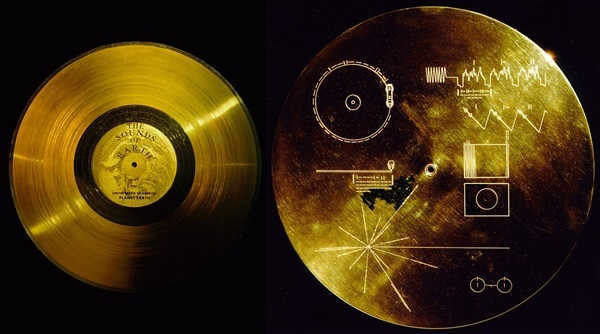
The Voyager’s gold plate (on the left) is a copper disk measuring 12 inches in diameter. Its aluminum cover is coated with a highly pure sample of uranium-238 through electroplating.
An extraterrestrial species might face significant challenges in interpreting the audio, music, and images found on the recording. The recording includes over 50 welcome messages in various languages. While the specific content of the messages may not be understandable, they will at least demonstrate to the listener the diversity of the beings responsible for the spacecraft’s creation.
Likewise, the assortment of chosen musical pieces illustrates the vast array of musical genres created by humans (ranging from the masterpieces of Beethoven and Stravinsky to the creations of Chuck Berry and other artists). Although the lyrics may be incomprehensible to extraterrestrial beings, the tempo and melody of a song can communicate a great deal to an alien audience.
The Voyager recording also includes numerous depictions of humans participating in different activities (such as consuming nourishment, examining objects under a microscope, and even venturing out into space). Although some of these depictions may be challenging to comprehend (such as an illustration of a woman licking an ice cream cone or a photograph of a string quartet), they do communicate the idea that humans have established a complex society with a certain level of advanced technology.
Delve deeper into other space probes that carry messages to extraterrestrial civilizations, as they serve a purpose beyond communication:
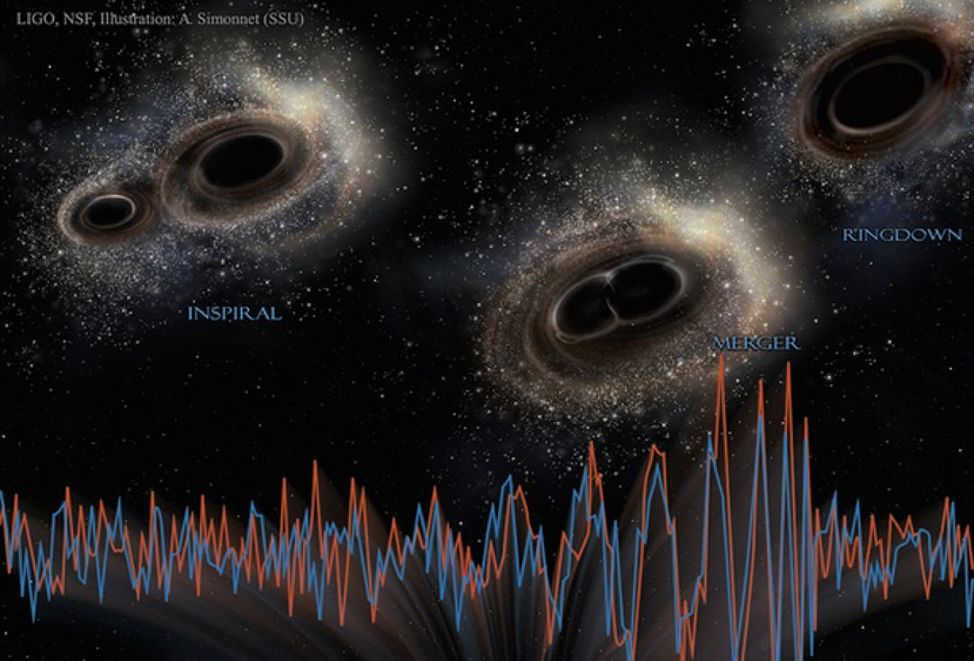
The concept of the “Music” of the universe is a well-known technique used in scientific research, where different celestial bodies are analyzed through their “sound.” Outer space is filled with various types of waves, including electromagnetic waves such as X-rays, gamma rays, ultraviolet rays, visible light, infrared radiation, and radio waves. By amplifying and converting these waves into sound signals, we can gain valuable insights.
There are two main reasons for converting cosmic radiation into sound waves:
- To gather information by analyzing repeated patterns of sound and identifying specific data sets for research purposes;
- To experience aesthetic pleasure through the auditory interpretation of cosmic phenomena.
Scientists are continually releasing compilations of celestial “music” (there’s no need to lament the infrequent release of new “albums”), allowing individuals to curate their own library of cosmic sounds, conduct scientific investigations, or create a remix. Alternatively, one can simply enjoy a concert performed by Mars.
The Universe’s “Breath”
The LIGO observatory recently captured gravitational waves and converted them into sound waves. Changes in the sound’s frequency are a direct reflection of the fluctuations in gravitational wave frequency.
The scientists at the Waterloo Institute for Theoretical Physics were so fascinated by the sound that they even recorded a blues rendition inspired by it.
Fast radio bursts (FRBs) are radio pulses of unknown origin that last for a few milliseconds and are detected by telescopes worldwide. These bursts are estimated to have an energy equivalent to the Sun emitting energy into space for tens of thousands of years.
The first fast radio burst was accidentally discovered in February 2007. It took a decade of research to determine that the source of these pulses is a dwarf galaxy located 3 billion light-years away from Earth. However, the exact cause of these bursts at the longer wavelengths of the electromagnetic spectrum is still a subject of debate.
Exploring the “Sounds” of Planets in our Solar System
Have you ever wondered how sound travels on the various planets in our solar system? Let’s take a closer look.
Mercury, being devoid of an atmosphere, is an eerily quiet place. However, if you were to press your ear against its surface, you might be able to detect faint vibrations. Unlike Mercury, Venus boasts a dense atmosphere composed mainly of carbon dioxide and nitrogen. Due to this density, sound waves on Venus can feel somewhat muted compared to traveling through air, but less dense than water.
On Mars, silence reigns supreme. However, when it comes to volume, Jupiter takes the crown as one of the loudest planets in our solar system. This gas giant is characterized by numerous cloud layers, which amplify any sounds, resulting in multiple echoes. To get a taste of the unique soundscape of Jupiter and other planets, check out the audio clip above.
Sounds from the Crimson Planet
Further information on Mars. The video was captured during the period spanning from January 2004 to April 2015 and displays a trajectory of 42.2 kilometers.
Opportunity’s microphone was employed on a device specifically designed for analyzing the chemical makeup of rocks and soil by vaporizing them using laser-induced breakdown spectroscopy technology. The laser is directed towards the target, causing it to rapidly disintegrate and generate a highly intense pressure wave, the acoustic signal of which is directly proportional to the mass of the sample being disintegrated. Incorporating a microphone into the apparatus not only aids in fine-tuning, calibrating, and focusing the laser for optimal performance, but also enables the capture of a multitude of novel sounds emanating from the surface of the Red Planet.
Cassini’s final performance
The Cassini probe, on the verge of sacrificing itself in the name of science, has captured the unique audio of numerous ring particles colliding with the surface at a rate of hundreds per second, transforming into an electrifying gas.
The symphony of a Saturnian thunderstorm
Additionally, Cassini is transmitting to scientists the captivating sounds that depict the tumultuous movement occurring deep within Saturn’s atmosphere, concealed beneath its clouds.
TRAPPIST-1 Symphony
Canadian scientists specializing in astrophysics have successfully detected the movement patterns of exoplanets within the TRAPPIST-1 system. Interestingly, these planets are situated in close proximity to the central star, resulting in a relatively short year of just slightly over 12 days for the sixth planet. The scientists have determined that the orbits of these celestial bodies exhibit a certain level of precision, as the periods of the planets are closely correlated in pairs, resembling integer ratios – commonly referred to as resonances. For instance, a 2:3 resonance signifies that for every three rotations of one planet, the other planet completes exactly two rotations.
“Cat” purr of comet Churyumov-Gerasimenko
Researchers at the European Space Agency utilized their Rosetta spacecraft to capture the sound emitted by the Churyumov-Gerasimenko comet as its magnetic field oscillates. In order for us to perceive this sound, its frequency has been amplified by a factor of approximately 10,000.
Galactic Symphonies
Experience a unique rendition of one of the most awe-inspiring events in the cosmos – the gamma-ray burst GRB 080916C. The celestial melodies you are about to hear perfectly correspond to the gamma rays captured by the Fermi Gamma-ray Space Telescope.
This extraordinary video showcases a harmonious fusion of 241 J1 Type Ia supernovae, captivatingly depicting the explosive demise of white dwarf stars. Each supernova has been assigned a musical note, meticulously composed according to the following guidelines:
- Note volume – representing the distance to the supernova, with more distant supernovae producing softer and more ethereal tones;
- Duration – determined by the luminosity parameters of the supernova, creating a musical expression of its brilliance;
- Instrument selection – supernovae residing in expansive galaxies are played on a resonant double bass, while those in more intimate galaxies are brought to life on a majestic grand piano.
Solar Choir
This recording was captured between 1998 and 2010 using a spectrometer on board NASA’s Advanced Composition Explorer spacecraft. It measured the speed of solar wind. To create this audio, 88,840 samples collected over a 12-year period were compressed into a two-second file, which was then looped. The resulting sound resembles noise with a frequency of approximately 68.5 Hz, corresponding to the 27-day solar rotation period.
Today, scientists at the University of Birmingham will perform the final chord of the Solar Choir. They have presented audio recordings of the sounds emitted by the oldest stars in our Milky Way galaxy, based on data gathered by the Kepler space telescope. By measuring the acoustic vibrations of multiple ancient stars in the M4 cluster, astronomers were able to recreate their unique sounds.
Experience the unique sounds of our solar system, from the powerful roar of Jupiter to the ethereal howl of the Mars’ surface.
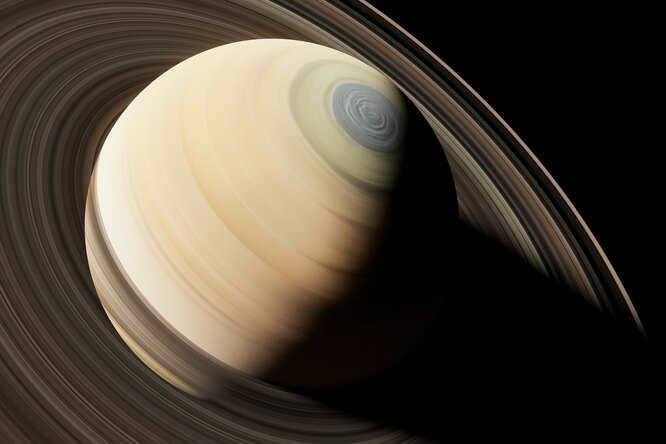
In order to detect the elusive sounds, researchers transformed radio emissions that were gathered during different space missions into audible sound waves. This process resulted in the creation of a complete compilation of planetary melodies.
NASA’s Perseverance rover has been capturing the “haunting melodies of Mars” ever since it landed in February 2021. Situated in the Jezero crater, the device is not just recording audio, but also searching for indications of extraterrestrial existence and capturing breathtaking imagery.
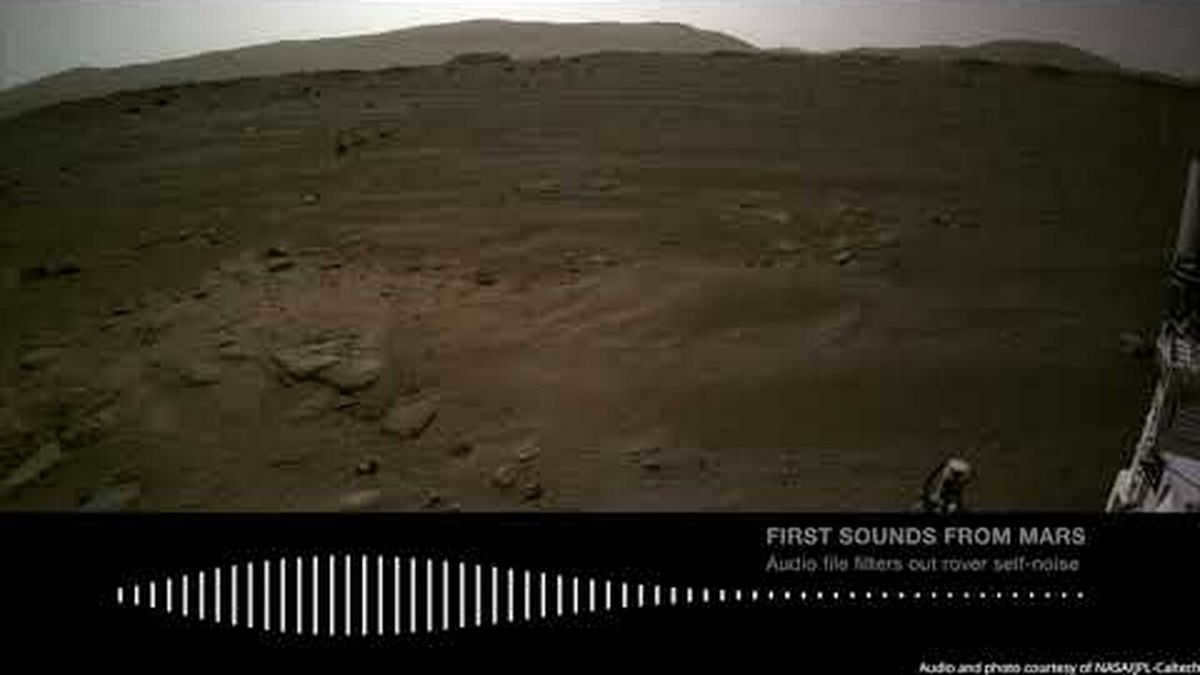
The sound of the Red Planet has been captured by Perseverance, making it the first lander to do so. This data is incredibly significant as it provides valuable insights into the Martian atmosphere.
Venus
Additionally, NASA has also recorded eerie sounds emanating from the upper atmosphere of Venus during a close encounter with the Parker Solar Probe, a mission launched to investigate the Sun.
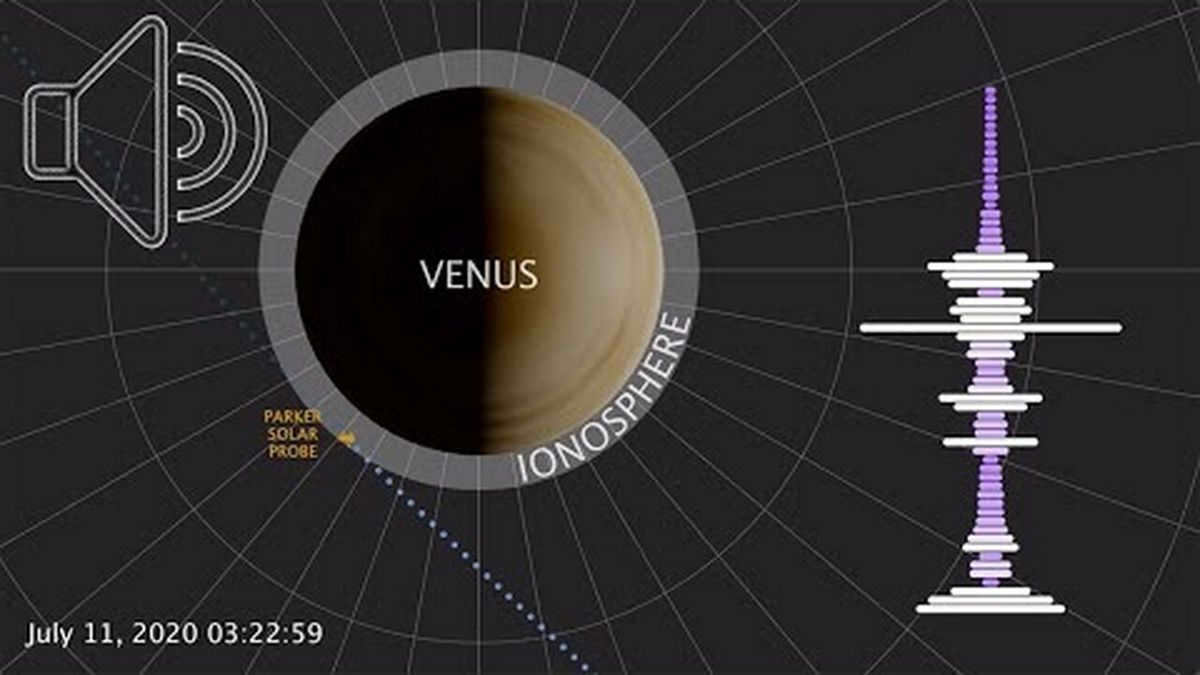
The NASA team has stated that this radio signal will provide valuable insights into the atmosphere of Earth’s “less hospitable counterpart.”
Planet Earth
In the year 2019, astronomers made a groundbreaking discovery as they captured the enigmatic “melody” emitted by Earth’s magnetic field during its encounter with a barrage of charged particles unleashed by the Sun.
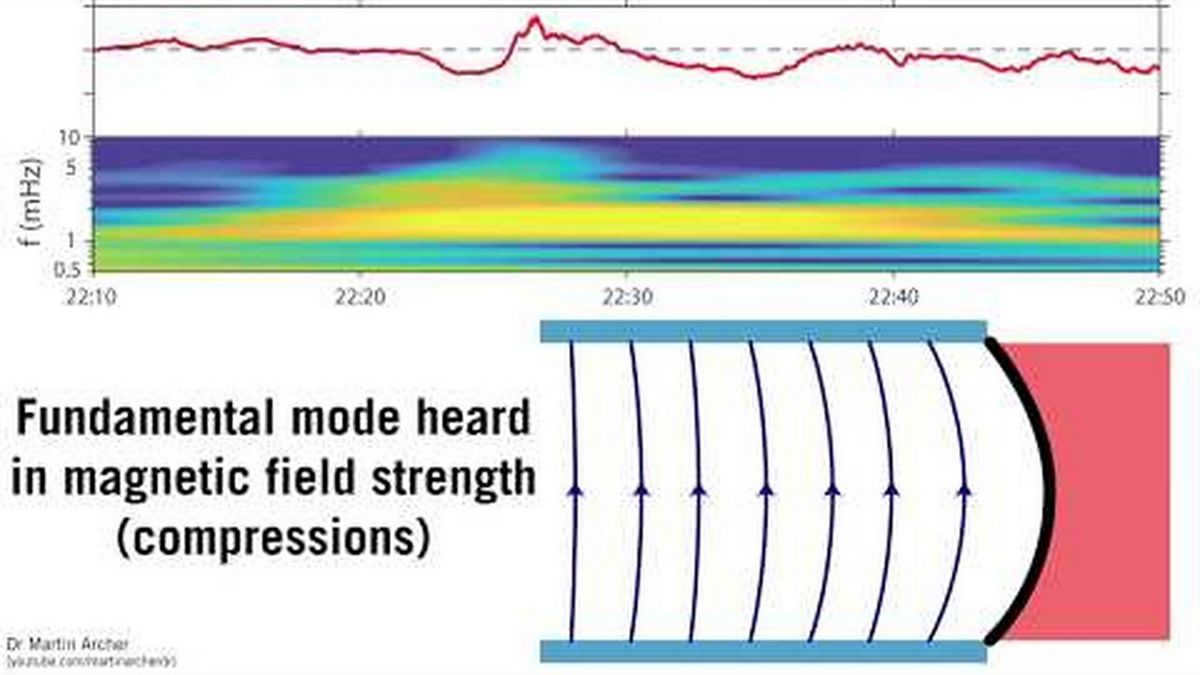
The “Melody” is a unique auditory representation of the mesmerizing display of aurora lights observed near the polar regions, where charged particles interact with the Earth’s atmosphere.
“Space Melodies.”
In 2019, NASA also unveiled an eerie collection of “space sounds,” which are the recorded radio emissions emitted by spacecraft as they journey through the solar system.
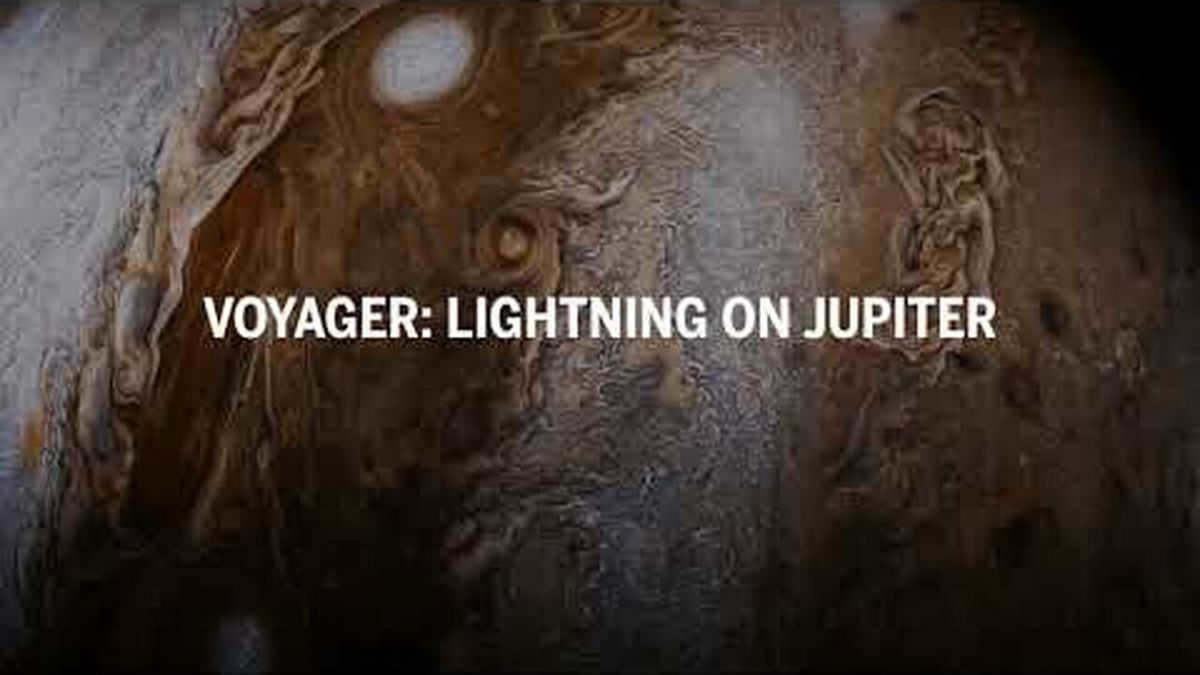
The space agency has recently unveiled its playlist called “Spooky Sounds from Around the Solar System” just in time for Halloween. This compilation consists of 22 snippets of eerie “space sounds” that provide a fascinating insight into the various planets and enigmatic entities within our solar system. Among the recordings, you can discern the haunting melodies of Jupiter’s magnetic field and the enigmatic radio emissions of Saturn.
TechInsider Network Edition
Founder of “Fashion Press” LLC: 119435, Moscow, Bolshoi Savvinsky per. 12, str. 6, floor 3, room II;
Editorial office address: 119435, Moscow, Bolshoi Savvinsky per. 12, p. 6, floor 3, room II; Editorial office address: 119435, Moscow, 12, Bolshoi Savvinsky per. 6, floor 3, room II;
Editor-in-Chief: Nikita Vasilenok
Editorial office e-mail address: [email protected]
Editorial office phone number: +7 (495) 252-09-99
Information product label: 16+
The online publication is registered with the Federal Service for Supervision in the Field of Communications, Information Technologies and Mass Media, registration number and date of registration decision: series EL No. FS 77 – 84123 dated November 09, 2022.
© 2007 – 2023 “Fashion Press” Ltd.
By uploading content to the website, the User is granting “Fashion Press” LLC non-exclusive permissions to utilize, replicate, distribute, generate derivative works, as well as exhibit the content and promote it to the general public without any cost.
It is well-known that sound waves have a unique characteristic that sets them apart from electromagnetic or gravitational waves, and that is their ability to travel only through an elastic continuous medium. In the vastness of space, however, there is emptiness. In interstellar space, the typical density of matter is approximately 10^6-10^7 atoms (mostly hydrogen) per cubic meter, with a temperature of T = 2.7 K (equivalent to about -270°C). According to the laws of molecular physics, the root mean square velocity of these atoms can be determined by the expression \( v_ = \sqrt \), where R = 8.3 J/(mol – deg) is the gas constant and M is the molar mass. For atomic hydrogen, M has a value of 10^-3 kg/mol. Therefore, the root mean square velocity of hydrogen atoms in interstellar space would be approximately 250 m/s.
Given these circumstances, a hydrogen atom collides with another atom roughly once every few billion seconds, meaning the collision rate ν ∼ 3 – 10 -10 s -1 , resulting in a collision-to-collision distance λ = vcp / ν ∼ 10 9 km (free path length) – a billion kilometers. If we assume that the length of the sound wave must obviously be longer than the free path length in matter and the frequency of sound is lower than the frequency of atom collisions, we can conclude that such sound would have a frequency of oscillations lower than a billionth of a second (less than 10 -9 Hz).
A sound like this cannot be detected by the human ear, as our hearing is limited to a frequency range of 20-20000 Hz. However, given the vast expanse of the Universe (approximately 46 billion light years or 43 – 10 22 km) and its immense age (around 14 billion years), it is conceivable that sound could originate from various locations in the Universe at different points in its evolution. Furthermore, sound serves as a valuable tool for exploring and studying the Universe.
Now, let us embark on a journey through space and time, for the deeper we peer into the vastness of the Universe, the further back in its history we will find ourselves. Our expedition will commence outside of our solar system, departing from the planet Earth.
Sound on Earth
As you are aware, sound serves as one of the most prevalent means of communication for animals and humans alike. Furthermore, sound plays a crucial role in the remote sensing of our planet’s environment, atmosphere, ocean, and structure (refer to the publication “The Physics of Sound” in Quantum #12, 2018) as well.
Firstly, let’s take a brief look at how we investigate sound on our planet. The Earth’s gravitational force has resulted in the formation of distinct layers comprising the atmosphere, ocean, and crust. Consequently, these conditions enable the presence of sound channels that allow for the transmission of sound over vast distances without significant loss of intensity. The speed at which sound travels is influenced by temperature and is also affected by wind speed in the atmosphere or currents in the ocean. Within the Earth’s crust, the speed of sound is contingent upon the density and structure of the matter it encounters. This characteristic has proven invaluable to seismologists as they use it to locate underground mineral deposits. Sound, when propagated across long distances in the ocean, has been discovered to be sensitive to minuscule fluctuations in average ocean temperature. This sensitivity can serve as an indicator of global warming (Figure 1). Acoustic tomography utilizes multiple intersecting acoustic paths to generate 4D representations of oceanic processes (comprising three-dimensional space along with time).
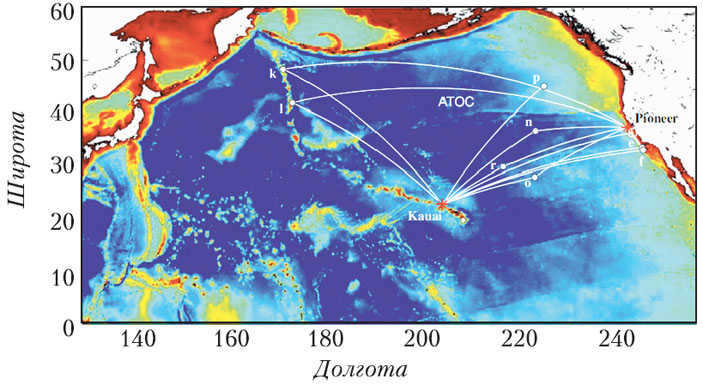
Figure 1. The diagram illustrates the process of acoustic thermometry in the Pacific Ocean (ATOS – Acoustic Thermometry of Ocean Climate). By measuring the time it takes for sound waves to travel long distances between Hawaii, the Aleutian Islands, and California, scientists can determine the temperature of the medium.
On Earth, we have a wide range of acoustic methods and tools that allow us to study the structure of the Earth’s crust, ocean, and atmosphere. However, when it comes to space exploration, there are certain constraints that need to be taken into consideration. Not all of the methods that we use on Earth can be applied in space due to these constraints.
First and foremost, the weight of the payload is a crucial constraint. The cost of transporting equipment to space is exorbitant, and many acoustic techniques, especially those utilizing low-frequency sound sources, require bulky equipment.
Secondly, there are restrictions on power consumption. In space, one must rely on hefty batteries or solar panels to generate electrical power for instruments used in space missions.
Thirdly, there is competition among various research methods. Electromagnetic and gravitational waves can be utilized for remote sensing without the need for an elastic medium, unlike acoustic methods that require on-site instrumentation. Acoustic methods prove particularly valuable in areas where they face no competition, such as the study of electrically conductive media like plasma, oceans, and the internal structures of planets where electromagnetic waves cannot penetrate.
Lastly, it’s essential to consider that the efficiency of acoustic methods may differ significantly on other planets compared to Earth. The effectiveness of acoustic techniques depends on the environmental conditions in which they are employed, and the pressure, temperature, density, and chemical composition of other worlds tend to deviate substantially from what we are familiar with here on Earth.
Unveiling the Mysteries of the Moon
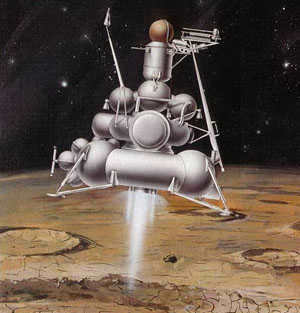

Figure 2. The Luna-16 lunar station successfully lands on the moon surface
The exploration of the Moon using instruments began in 1959 with the landing of the Soviet station Luna-2. The first manned mission to the Moon was carried out by the American spacecraft Apollo 11 in 1969. This historic expedition was followed by several more, with the last one being the Apollo 17 mission in 1972. These missions allowed for various observations and the collection of lunar soil samples. In parallel, the USSR launched several automatic lunar stations, including Luna-16 in 1970 and Luna-24 in 1976. These stations also conducted research on the Moon and returned lunar soil samples to Earth (Fig. 2).
Automated Luna stations were utilized to deliver cores of lunar regolith to Earth, which were obtained through drilling to a depth exceeding 2 meters. In order to ensure successful drilling and acquire undisturbed cores, the drill was supplemented with ultrasonic perturbation. This innovative ultrasonic technology enabled the retrieval of high-quality core samples, which unveiled the intricate structure of the lunar regolith. Through careful analysis of the data collected from these missions, the first concrete evidence of water’s presence on the Moon was discovered. It wasn’t until the 1990s that the Americans were able to achieve similar results, confirming the existence of water within the lunar soil!
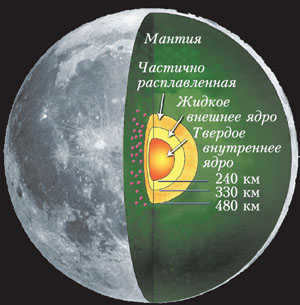
Figure 3. The Moon’s Inner Composition
It is important to mention that although seismic and other experiments on the Moon were concluded in 1977, the data collected from lunar seismic sensors were reanalyzed in 2010 using advanced computer technology. Interestingly, this analysis unveiled a previously unknown composition of the lunar core: a solid inner core surrounded by a liquid outer core, encased by a layer of partially molten magma (Fig. 3).
The knowledge acquired from seismic studies on the Moon is now being successfully applied to the examination of asteroids. An automated station installs seismic receivers on the surface of an asteroid, which record both artificial and natural disturbances as well as their echoes from the internal structure.
Sound in the Sun
The Sun is a rather dense structure of ionized gas. There is no doubt that sound exists within the Sun. Undoubtedly, the intense swirls of hot gas in its upper layers and the turbulence generate a tremendous noise across a wide range of frequencies. Nevertheless, we are unable to hear this noise on Earth due to the 150 million kilometers of vacuum that separates us from the Sun, preventing sound from traveling through.
In the higher layers of the solar atmosphere, the gas is cooler compared to the deeper layers. Based on previous research on how sound travels in a layered medium, it is expected that sound will concentrate in the area with the slowest speed of propagation, which is the layer with the lowest temperature. Sound waves, generated by turbulent movements in convective zones, travel in a way that keeps them in the upper layers of the solar atmosphere (Fig. 4). As the depth increases, both the speed of sound and temperature increase rapidly, causing the sound waves to be pushed back into the convective zone. Since the Sun is spherical in shape, sound waves that propagate in cyclic paths along the surface of the Sun (p-modes in Figure 4, which are pressure waves) will be amplified if the number of cycles is a whole number. In this scenario, the Sun can be considered as a resonator where specific oscillations, known as spherical modes, are amplified.
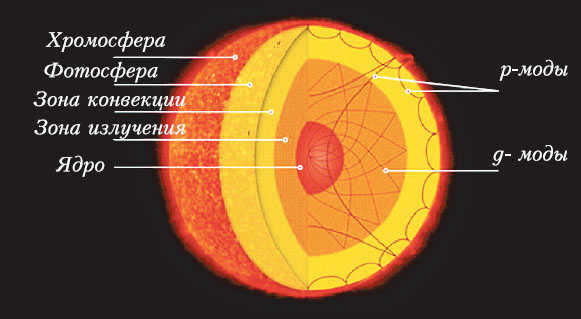
Figure 4. The Sun has a layered structure, and sound travels along specific paths. When sound moves in cycles, it becomes stronger and creates pressure fluctuations on the surface (known as p-modes) and internal waves in the gravitational field (known as g-modes)
It should be noted that the Sun does not have the ability to produce shear waves that are effective in seismic problems on Earth or other planets. The Sun is composed of a dense gas (or liquid), which lacks a shear modulus necessary for shear wave propagation. Instead, the solar medium can only support the propagation of non-elastic pressure waves, particularly in the radiation zone and core where gravitational forces dominate over elastic forces. These waves, known as internal waves or g-modes (as shown in figure 4), are driven by buoyancy forces and represent a hydrodynamic rather than an acoustic phenomenon. However, these g-modes attenuate in the region of convective flows and do not reach the surface of the Sun. As a result, the surface of the Sun does not provide any information about the conditions in its core.
Therefore, it appears that the sound emitted by the Sun can be detected on Earth.
The Big Bang: Shaping our Universe through Sound
The prevailing consensus is that our universe came into existence through a remarkable cosmic event known as the Big Bang. The detection of residual electromagnetic radiation in 1964 serves as confirmation of this occurrence and the subsequent expansion of the universe.
The origins of acoustic waves can be traced back to the inception of our Universe. In the aftermath of the Big Bang, the Universe existed as a scorching quark-gluon plasma. However, as space expanded, this plasma gradually cooled down. As a result, all the fundamental particles that comprise visible matter began to emerge. Eventually, the temperature dropped to a level where protons and electrons could combine to form atoms, causing matter to transition into a neutral state (known as recombination) and separating radiation from it. This radiation, known as relic radiation, is still detectable today in the form of electromagnetic background radiation. These phenomena serve as the foundational milestones in the early stages of our Universe’s evolution, as described by the Big Bang theory.
The uniqueness of this theory lies in its ability to explain the variations in density that emerged from the uncertainty principle of quantum mechanics. Within the original hot expanding plasma, which consisted of dark matter, baryons, electrons, photons, and neutrinos, regions of excessive matter density and regions of rarefaction appeared, giving rise to potential sound waves. The opposing gravitational and pressure forces in this scenario generate elastic vibrations in the medium, resembling how sound is produced in the air due to rapid pressure fluctuations. During the early stages of the Universe, these acoustic waves had relativistic velocities, slightly exceeding half the speed of light!
Approximately 380,000 years after the start of the Universe’s history, the plasma that was expanding began to cool down enough (below 3000 K) for electrons and protons to combine and form stable neutral atoms, primarily hydrogen. This allowed photons to be freely emitted, as the ionized plasma no longer absorbed electromagnetic radiation. Since neutral atoms cannot absorb electromagnetic energy significantly, the photons were able to travel any distance. This event occurred when fluctuations in the density of the medium, both increased and decreased (known as acoustic waves), froze in a phase corresponding to the last radiation. Consequently, the medium lost its elasticity and stable fluctuations in the density of matter in the Universe emerged, which are evident in the spatial fluctuations of relic electromagnetic radiation.
In Figure 5, we can observe a depiction of relic radiation fluctuations originating from various locations across the celestial sphere, providing insights into the acoustic fluctuations in the early stages of the Universe. What can we uncover from analyzing this map? The fluctuations in the relic radiation exhibit an intensity ranging between 10 -4 and 10 -5 times the average value. Consequently, the relative extent of pressure fluctuations in the medium was of a similar magnitude, resulting in highly pronounced acoustic oscillations. In essence, the sound noise accompanying these pressure fluctuations is ten times more intense than the noise experienced in a subway. This indicates the existence of sound waves with substantial amplitudes in the early Universe. Furthermore, perturbations in the medium’s density signify the seeds for the future structure of the Universe. Regions with excessive density in the young Universe gave rise to galaxies and galaxy clusters, which possess a density a million times greater than the average density of the Universe. On the other hand, less dense regions contributed to the formation of vast cosmic voids.
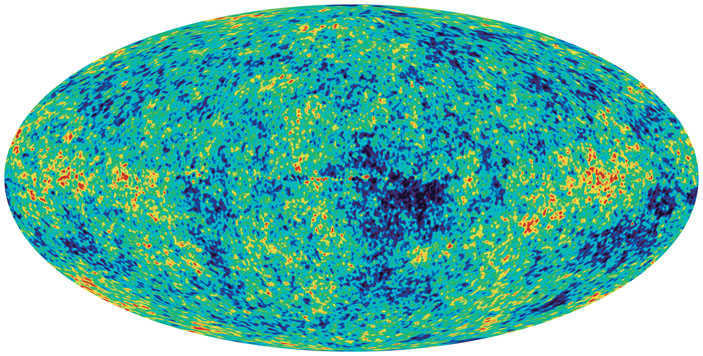
Figure 5. A map has been created that shows the background relic electromagnetic radiation of the Universe. This map was compiled using satellite observations over a period of 9 years. To highlight the fluctuations, the spectrum of the absolute blackbody radiation was subtracted from the results. The average interstellar temperature used for this subtraction was 2.725 K. The map uses colors to represent temperature, with yellow and red indicating higher temperatures and blue indicating lower temperatures. The fluctuations in the relic radiation have an intensity ranging from 10 -4 to 10 -5 of the average value.
The density distribution picture displayed in Figure 5 provides us with an understanding of the spatial range of these variations. Figure 6 illustrates the spectrum of relic radiation variations based on the angular size of its source. Firstly, it can be observed that there is a distinct angular size in the spatial density distribution that corresponds to the primary peak in the spectrum. In our spectrum, the size of the spatial density variations during the early Universe only slightly deviates from 1°, indicating a sufficient level of spatial uniformity in the variations. Additionally, the presence of additional peaks allows for the examination of the intricate structure of the early Universe. Experts suggest that the ratio of the following peak to the initial peak (or generally, the odd to even peaks) determines the baryonic density of the medium, while the third peak provides information about the density of dark matter.
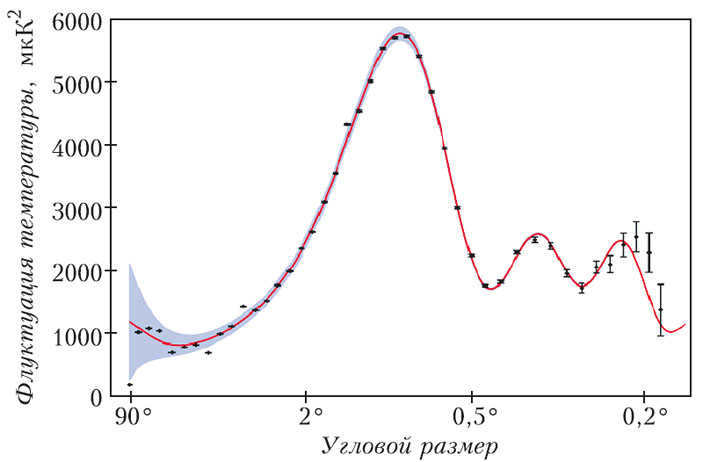
Figure 6. Spatial spectrum of the relic electromagnetic radiation fluctuations of the Universe
The relic radiation’s electromagnetic waves have provided us with insights into the acoustic vibrations that existed in the universe billions of years ago. Another way sound is utilized in astronomy is to enhance our ability to interpret various types of data, particularly those that we have limited experience processing. Sometimes, new information can be better understood with our ears rather than our eyes. For instance, our eyes can detect images that flicker at a frequency of 10 Hz or less, while our ears can perceive changes in processes up to 20 kHz. Additionally, our ears can pick up on subtle details that may not be immediately apparent on time-lapse diagrams or spectra. As a result, it is common practice to convert electrical signals of all sorts into sound in order to analyze them using our auditory perception.
The detection of gravitational waves through the Laser Interferometer Gravitational-Wave Observatory (LIGO) provides an interesting example. During the observation of black hole mergers, it was discovered that the gravitational waves generated in this event caused disturbances in the laser emissions within the acoustic frequency range. In order to understand these gravitational perturbations, the signal from the interferometer was transferred to a loudspeaker. This innovative technique allowed for the identification of a 0.2-second frequency-modulated chirp within the noise. This chirp was found to correspond to the increasing speed at which the black holes were twisting during the merger. Once this initial understanding of the registered signal was obtained, standard processing procedures could be employed, which are undoubtedly more reliable and objective than relying solely on auditory perception.
Conclusion
So, how can we address the question asked in the title of this article? Can sound occur in space? The answer is no. Sound can only exist and travel through an elastic medium. Sound is the result of elastic fluctuations in the medium, such as changes in density, pressure, and temperature. Unfortunately, interstellar space is an extremely thin medium. Atoms of interstellar gas travel billions of kilometers between collisions. Therefore, sound is virtually impossible in these conditions. However, it is important to note that the Universe was actually born with sound. Sound vibrations in the early Universe played a crucial role in shaping its current structure. The acoustic vibrations in the plasma of the early Universe provided the initial momentum for the formation of galaxies. So, without sound, the Universe as we know it would not exist!
Sound plays a crucial role in the exploration of outer space. The study of planetary bodies and asteroids, as well as the detection of water on the lunar surface, have all been made possible with the aid of sound. It is through sound that scientists are able to investigate the composition and structure of the sun. In fact, when it comes to examining electrically conductive media such as plasma, oceans, and the internal makeup of planets, sound has no rival. Unlike electromagnetic waves, sound waves can penetrate these mediums, providing valuable insights into their characteristics. Without the use of sound, our understanding of the cosmos, including its overall structure and the composition of celestial bodies, would be woefully incomplete. In essence, sound is an invaluable tool for unraveling the mysteries of the universe.

